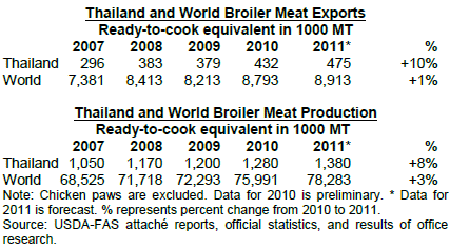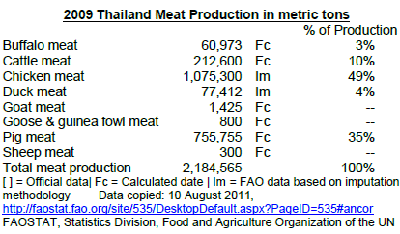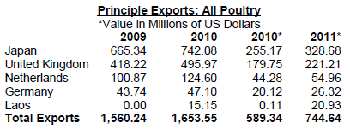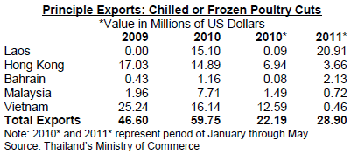



International Egg and Poultry Review: Thailand
THAILAND - This is a weekly report by the USDA's Agricultural Marketing Service (AMS), looking at international developments concerning the poultry industry. This week's review looks at poultry industry expansion in Thailand.An outbreak of highly pathogenic avian influenza (HPAI) in Thailand in 2004 severely reduced poultry exports and led to stricter regulations on imported Thai poultry meat. Some countries currently only accept prepared (cooked) Thai poultry imports. Since 2004, broiler meat exports have started to rise, despite a few trade barriers. In 2008, Thailand accounted for 4.6 per cent of the world's total broiler meat exports. That same year (2008) Thailand was the 15th largest producer of chicken meat. Exports of canned chicken totaled 400,073 metric tons (MT), making them one of the world’s top exporters of that product. It was their third most valuable export that year behind milled rice and rubber. Exports are projected to continue increasing, which has brought some increased attention to the Thai poultry industry.

Currently, only processed chicken products from Thailand are allowed into Japan due to Thailand's 2004 avian influenza outbreak. Despite the outbreak's negative effect, Thai poultry exports to Japan have been steadily increasing and are projected to continue to do so. In 2009, Thailand was responsible for 56 per cent of Japan's prepared poultry meat imports; poultry exports to Japan for the January to May period of 2011 are already 28.8 per cent higher than the same January to May period of 2010.
Brazil and the United States are currently the major suppliers of frozen broiler meat to Japan. If Thailand were also allowed to export frozen broiler meat, it would see expansion in their export markets. Director of the International Trade Promotion Office in Japan, Amphawan Pichalai, pointed out that Japan typically follows suit with the EU in regard to trade policy it would be wise to push for EU reform first.

FAOSTAT reports that over half of Thailand's meat production is poultry meat. USDA estimates that 52 per cent of Thailand's animal feed is consumed by chickens; 35 per cent credited to broilers, three per cent higher than the 32 per cent by pigs.



Increased demand for Thai poultry has prompted both international and domestic investment in Thai poultry operations. A United States-based company also has expansion plans in mind for Thailand. It would increase production by 24,000 metric tons once the facilities are complete in two years. The investment for the planned expansion totals around $110 million. Around 2,000 new jobs would be created while they currently employ about 9,500 people in the country.
As of April 2011, per-capita broiler meat consumption in Thailand was 12.8kg, according to FAS. This is low compared to the US (44.5kg) but similar to the per-capita consumption of Japan (16.5kg) or China (9.6kg). With increased production and relatively steady consumption rate. USDA estimates 34.4 per cent of Thailand's total poultry produced in 2011 will be exported.
Sources: USDA Foreign Agriculture Service, FAPRI, United Nations Food and Agriculture Organization FAOSTAT, Ministry of Commerce Thailand, National News Bureau of Thailand, news releases
Further Reading
| - | You can view the full report by clicking here. |









